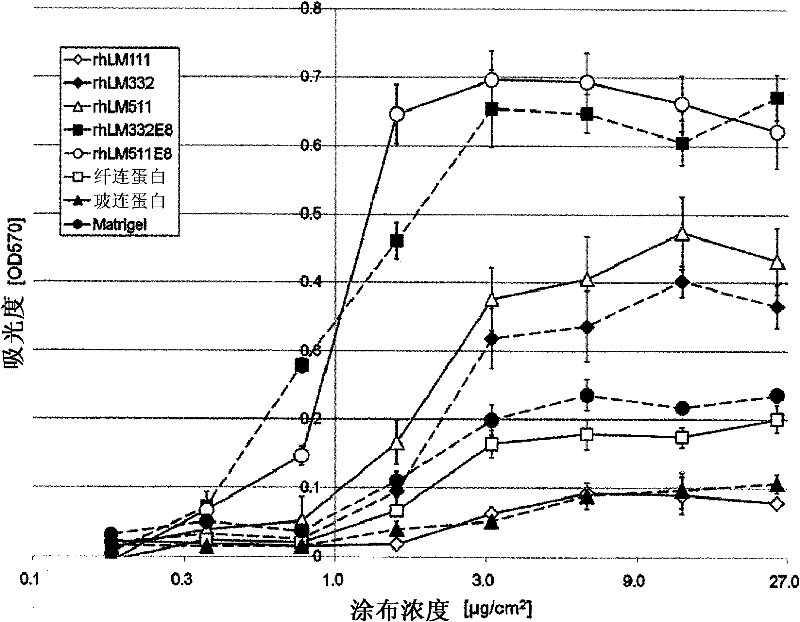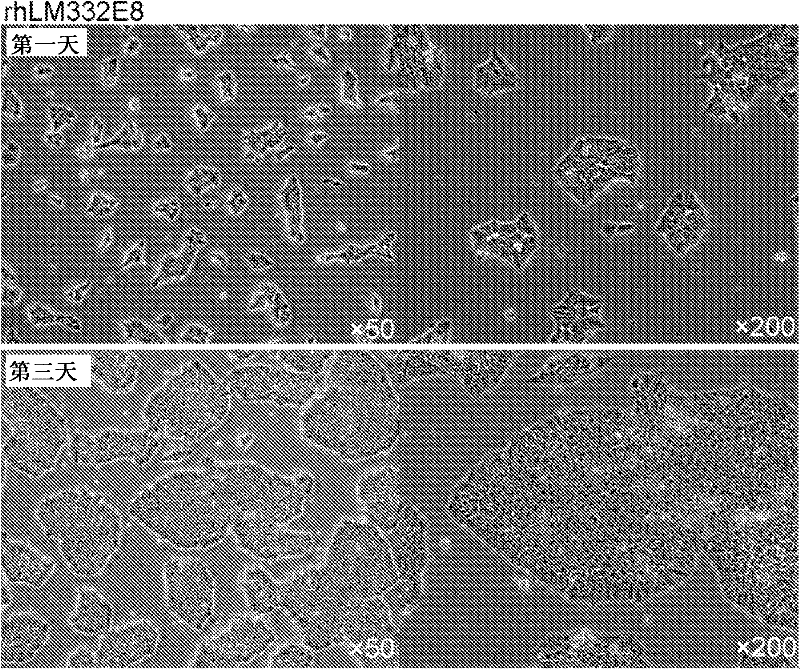Culture substratum for human pluripotent stem cells, and use thereof
A technology for human pluripotent stem cells and culture substrates, which is applied in the field of culture substrates for human pluripotent stem cells, can solve the problems of difficult technology and low yield, and achieve the effects of low cost, rapid expansion, and high safety
- Summary
- Abstract
- Description
- Claims
- Application Information
AI Technical Summary
Problems solved by technology
Method used
Image
Examples
Embodiment 1
[0165] [Example 1: Comparison of concentration-dependent adhesion efficiency of human ES cells in various extracellular matrices]
[0166] Dilute rhLM511E8, rhLM332E8, rhLM511, rhLM332, rhLM111, matriogel, fibronectin, and vitronectin with Dulbecco's PBS (Wako Pure Chemical #045-29795) or DMEM-F12 (SIGMA #D6241), in a 96-well microplate (BD Bioscience #351172) was added to each extracellular matrix solution to achieve a final concentration of 0-25 μg / cm 2 range, stand at room temperature for 2 hours for coating.
[0167] Add TrypLE Select (Invitrogen #12563011) to mTeSR1 cultured cells (P1), and treat at 37°C for 3 minutes to disperse the cells into single cells. After counting the number of cells, 5×10 4 Density of cells / well Cells were seeded into microwell plates. Six hours after cell seeding, the supernatant was removed, the wells were washed once with DMEM-F12, and the cells were fixed by adding 10% neutral buffered formalin for 10 minutes. After replacing with 100% e...
Embodiment 2
[0169] [Example 2: Study of Adhesion Efficiency of Single Human ES Cells Dependent on Seeding Density in Culture Vessels Coated with rhLM511E8]
[0170] In the subculture of human ES cells, the viability of the cells is extremely low when they are dispersed into single cells using trypsin / EDTA, etc., so they are generally subcultured while maintaining the colony shape. Therefore, the adhesion efficiency of single human ES cells when rhLM511E8 was applied was compared with that of single human ES cells when matrigel was applied.
[0171] Dilute rhLM511E8 with Dulbecco’s PBS to a final concentration of 1.5 μg / cm 2 . Dilute matriogel with DMEM-F12 to a final concentration of 25 μg / cm 2 . Each dilution was added to a 48-well multiwell plate (BD Bioscience #351178) and allowed to stand at room temperature for 2 hours for coating.
[0172] Add TrypLE Select to mTeSR1 cultured cells (P1), and treat at 37°C for 3 minutes to disperse the cells into single cells. In a 48-well multi...
Embodiment 3
[0174] [Example 3: Morphological observation and surface antigen analysis of human ES cells in culture vessels coated with rhLM511E8 or rhLM332E8]
[0175] Dilute rhLM511E8 or rhLM332E8 with Dulbecco’s PBS to a final concentration of 1.5 μg / cm 2 . Dilute matriogel with DMEM-F12 to a final concentration of 25 μg / cm 2 . Each dilution was added to a 35 mm i-Grip cell culture dish (BD Falcon #353001), and allowed to stand at room temperature for 2 hours for coating.
[0176] Add TrypLE Select to mTeSR1 cultured cells (P1), and treat at 37°C for 3 minutes to disperse the cells into single cells. In a 35mm easy-to-grip cell culture dish coated with rhLM511E8, rhLM332E8 or matriogel, 5×10 4 cells / cm 2 seeded at a cell density. Observation was carried out every day from the beginning of cell inoculation, and the morphological changes were photographed and recorded.
[0177] Five days after cell inoculation, for surface antigen analysis, the cells were treated with TrypLESelect ...
PUM
 Login to View More
Login to View More Abstract
Description
Claims
Application Information
 Login to View More
Login to View More - R&D
- Intellectual Property
- Life Sciences
- Materials
- Tech Scout
- Unparalleled Data Quality
- Higher Quality Content
- 60% Fewer Hallucinations
Browse by: Latest US Patents, China's latest patents, Technical Efficacy Thesaurus, Application Domain, Technology Topic, Popular Technical Reports.
© 2025 PatSnap. All rights reserved.Legal|Privacy policy|Modern Slavery Act Transparency Statement|Sitemap|About US| Contact US: help@patsnap.com



